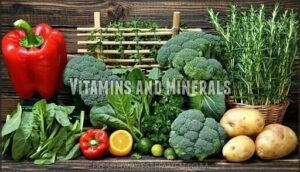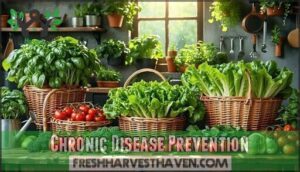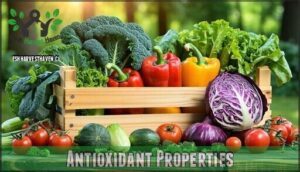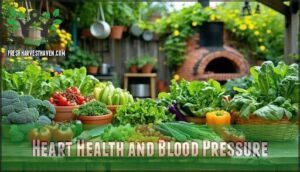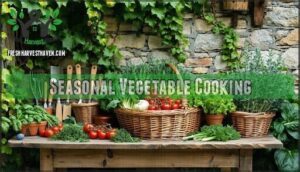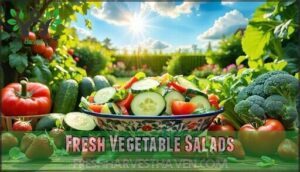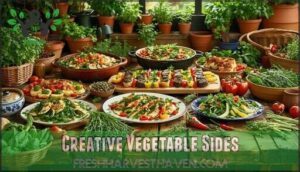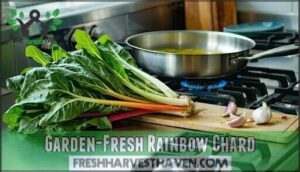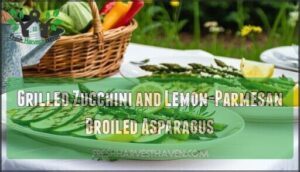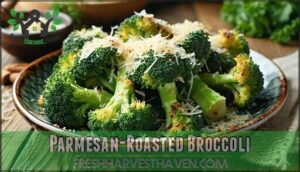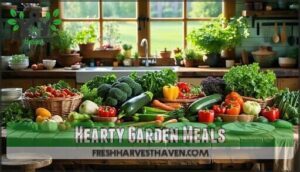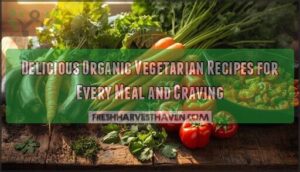This site is supported by our readers. We may earn a commission, at no cost to you, if you purchase through links.
 You’ll discover the full potential of cooking garden vegetables when you master timing and technique.
You’ll discover the full potential of cooking garden vegetables when you master timing and technique.
Fresh-picked vegetables need minimal cooking – just 5-10 minutes for most greens, 15-20 for root vegetables.
Start with high heat to caramelize natural sugars, then reduce temperature to preserve nutrients.
Season simply with salt, pepper, and herbs from your garden.
Roasting at 425°F brings out sweetness in carrots and Brussels sprouts, while quick sautéing keeps delicate vegetables like zucchini crisp-tender.
The secret lies in understanding each vegetable’s unique personality and cooking requirements.
Table Of Contents
- Key Takeaways
- Garden Vegetable Recipes
- Nutritional Garden Benefits
- Seasonal Vegetable Cooking
- Vegetable Centric Dishes
- Hearty Garden Meals
- Frequently Asked Questions (FAQs)
- Is it safe to eat vegetables grown in the backyard?
- How do you prepare a garden for beginners?
- What to make with my garden vegetables?
- How do I know when garden vegetables are perfectly ripe?
- Whats the best way to wash garden vegetables?
- How long do fresh garden vegetables stay good?
- Can I freeze fresh vegetables from my garden?
- Which garden vegetables should never be eaten raw?
- Conclusion
Key Takeaways
- Master timing and temperature – Cook fresh-picked vegetables for just 5-10 minutes (greens) or 15-20 minutes (root vegetables), using high heat first to caramelize sugars, then reducing to preserve nutrients.
- Unlock maximum nutrition – You’ll retain up to 95% of nutrients through proper techniques like blanching before freezing, and consuming within 24-48 hours of harvest, when vitamin C levels are 40% higher.
- Transform vegetables into satisfying main dishes – Create hearty meals like stuffed poblano peppers, garden vegetable gnocchi, and grilled zucchini that prove vegetables aren’t just sides, but can be the star of your plate.
- Preserve your harvest effectively – Use blanching and freezing, pressure canning for low-acid vegetables, dehydrating, pickling, and fermenting to extend your garden’s bounty year-round, while maintaining flavor and nutrition.
Garden Vegetable Recipes
You’ll discover how fresh garden vegetables transform into restaurant-quality dishes with these five standout recipes.
Each recipe maximizes your harvest’s nutritional potential while delivering bold flavors that’ll make your taste buds sing.
Stuffed Poblano Peppers
Bursting with earthy heat, poblano peppers transform into satisfying vessels when you master proper roasting techniques.
You’ll achieve perfect char by broiling these mild pepper varieties for 8-10 minutes, creating ideal pockets for spicy fillings.
Mix ground turkey with cumin and cheese for balanced flavor profiles. At 312 calories per serving, these stuffed peppers deliver complete nutrition while showcasing your garden-to-table cooking skills perfectly.
Crunchy Lemon-Pesto Garden Salad
This vibrant salad transforms garden greens into a restaurant-quality dish with homemade pesto sauce and bright lemon zest.
You’ll combine fresh herbs, crunchy vegetables, and tangy salad dressing for maximum flavor impact.
The combination delivers 159 calories per serving while providing essential vitamins from garden vegetables.
Perfect for showcasing your vegetable salad recipes collection, with a focus on garden greens and maximum flavor impact.
Dill Chicken Soup
You’ll transform garden dill into this comforting chicken soup that delivers 198 calories per serving.
The fresh herb elevates ordinary chicken broth while garden vegetables add nutritional punch. This soup nutrition powerhouse works perfectly for meal prep.
- Fresh dill provides distinctive flavor that complements tender chicken
- Garden vegetables like carrots and celery boost vitamins and fiber content
- Ready in 30 minutes, making it ideal for weeknight chicken recipes, with garden vegetables and fresh dill.
Cajun Sirloin With Mushroom Leek Sauce
After soup’s comforting warmth, you’ll love this protein-packed garden dish.
Cajun spice transforms sirloin cuts into bold beef cooking perfection, while mushroom leek sauce adds earthy richness.
This garden to table recipe delivers 325 calories per serving with 32g protein. The mushroom sauce pairs beautifully with fresh leeks from your vegetable garden, creating restaurant-quality results at home.
Sesame-Ginger Cucumber Salad
This invigorating cucumber salad brings cool relief after hearty dishes. You’ll love how cucumber benefits include hydration and low calories, while sesame oil and ginger health properties add Asian flavors that make garden vegetables shine.
The salad’s success relies on using fresh ingredients from seasonal garden harvest recipes.
- Prep Time: 15 minutes for this quick vegetable recipes favorite
- Sesame Dressing: Combines sesame oil, rice vinegar, and fresh ginger
- Cucumber Benefits: High water content keeps you hydrated during summer
- Perfect Pairing: Ideal for refreshing lunches alongside grilled proteins
Nutritional Garden Benefits
When you grow your own vegetables, you’re creating a nutritional powerhouse that delivers impressive health benefits with every harvest.
These garden-fresh ingredients pack essential vitamins, minerals, and antioxidants that can reduce your risk of chronic diseases by up to 30% while supporting your immune system and heart health.
Vitamins and Minerals
Garden vegetables pack nutritional punch with impressive vitamin and mineral content.
Red bell peppers deliver 140mg of Vitamin C per 100g, while spinach provides 120% daily value for vitamin K.
These mineral rich powerhouses offer excellent iron sources – kale and spinach boost iron levels substantially.
Calcium benefits come from broccoli’s 35mg per cup, supporting bone health.
Potassium content reaches 888mg in medium potatoes, promoting heart function.
Incorporating Vitamin C sources into meals can greatly enhance immune support.
Chronic Disease Prevention
Everyone knows that eating your vegetables is healthy, but the science behind chronic disease prevention is truly remarkable.
Research shows that each additional serving of vegetables per day reduces your premature death risk by 5%, while higher fiber intake from garden vegetables lowers cardiovascular disease risk by up to 28%.
These nutrition facts make vegetable recipes your strongest wellness strategies for healthy eating and long-term prevention. Understanding the importance of daily fruit intake can further enhance your approach to a balanced diet.
Antioxidant Properties
Your garden’s antioxidant-rich vegetables pack potent plant compounds that combat free radicals and oxidative stress.
These phytochemicals deliver anticancer properties and antiinflammatory benefits while enhancing nutrient absorption.
Here’s what makes your harvest so powerful:
- Leafy greens contain high concentrations of beta-carotene and vitamin C
- Colorful peppers provide capsanthin and flavonoids for cellular protection
- Tomatoes offer lycopene, especially when cooked with healthy accompaniments
- Purple vegetables deliver anthocyanins that support brain health
- Cruciferous vegetables supply sulforaphane for detoxification support
Dietary Fiber and Gut Health
Your gut bacteria thrive on fiber intake from garden vegetables, transforming these prebiotics into digestive health champions.
Each serving of fiber-rich meals feeds beneficial microorganisms that support your intestinal ecosystem.
Fresh vegetable recipes deliver the prebiotics your system craves, while healthy gardening helps you’re growing tomorrow’s gut-healing ingredients.
Garden fresh recipes naturally boost your fiber intake beyond typical Western diet levels. Incorporating healthy garden recipes into your diet can have a significant impact on overall nutritional well-being.
Heart Health and Blood Pressure
Your heart’s best friend might be sitting in your garden right now.
Regular intake of fresh vegetables naturally supports vascular care and hypertension management through powerful compounds that promote healthy circulation.
- Potassium-rich vegetables like leafy greens help regulate blood pressure naturally
- Heart healthy recipes featuring lowfat, vegetarian preparations reduce cardiovascular strain
- Fresh vegetables provide nitrates that improve blood flow and support cardio health
Seasonal Vegetable Cooking
You’ll master seasonal cooking by timing your harvest perfectly and pairing vegetables at their peak flavor. Smart storage and preserving methods help you enjoy garden-fresh taste year-round.
Summer Vegetable Recipes
Summer brings abundant fresh produce that transforms into vibrant Garden Delights with minimal effort.
You’ll create stunning Grilled Vegetables by tossing tomatoes, zucchini, and peppers with olive oil before charring them perfectly. Summer Salads showcase cucumbers and herbs, while colorful Vegetable Skewers make entertaining effortless.
These summer vegetable recipes prove that cooking garden vegetables doesn’t require complexity—just quality ingredients and simple techniques for unforgettable Roasted Veggies. The key to achieving perfect grilled dishes is understanding grilled vegetable techniques.
Spring Vegetable Recipes
As spring arrives, your garden offers tender treasures perfect for quick cooking.
Fresh spring vegetables reward you with delicate flavors that capture the season’s brief bounty.
Spring’s star performers include:
- Asparagus Tips – pencil-thin spears ideal for lemon asparagus pasta in just 15 minutes
- Pea Recipes – sweet pods that shine in French-style preparations with fresh herbs
- Spring Salads – vibrant mixes featuring delicate herb pairings and seasonal vegetables
You’ll find these tender vegetables cook faster than their summer counterparts.
Herb pairings like dill, chives, and parsley complement spring’s precious harvest perfectly.
Local Sourcing and Storage
You’ll regularly discover that local sourcing transforms your garden bounty into peak nutrition.
Farm fresh produce from community gardens and local markets retains up to 40% more vitamin C when consumed within 24-48 hours of harvest.
Smart food storage techniques preserve seasonal produce quality—store leafy greens at 35-40°F with high humidity for ideal freshness lasting 1-2 weeks.
Understanding seasonal produce is key to maximizing the nutritional value of your garden vegetables, through proper storage.
Preserving Methods
Once you’ve mastered local sourcing and storage, preserving methods become your safety net against seasonal abundance.
Freezing retains 95% of nutrients when you blanch vegetables first, while canning low-acid produce requires pressure canning at 240°F for safety.
Dehydrating removes 90% moisture, and pickling creates acidic environments that prevent spoilage.
Fermenting produces probiotic-rich vegetables that’ll keep for months.
Proper food storage using freezer container systems is essential for maintaining the quality of frozen vegetables.
Seasonal Pairings and Peak Seasonality
Discover the magic of seasonal pairings by timing your garden delights perfectly with peak harvest windows.
Fresh combinations shine when you match culinary timing with nature’s rhythm. Seasonal cooking transforms ordinary garden vegetables into extraordinary seasonal recipes through strategic peak seasonality planning.
- Summer Power Trio: Tomatoes, basil, and peppers create the ultimate seasonal flavors when harvested together in July-August
- Spring Symphony: Asparagus, peas, and radishes offer crisp textures and bright tastes during March-May peak harvest
- Fall Comfort Blend: Root vegetables like beets, carrots, and winter squash deliver rich, earthy seasonal pairings September-November
Vegetable Centric Dishes
You’ll discover that transforming your garden harvest into restaurant-quality dishes doesn’t require complicated techniques—just fresh ingredients and simple preparation methods.
These vegetable-centric recipes showcase your produce’s natural flavors while providing complete nutritional profiles that’ll satisfy your family’s dietary needs.
Fresh Vegetable Salads
Fresh vegetable salads showcase your garden’s bounty with vibrant colors and satisfying crunch.
You’ll love mixing crisp cucumbers with juicy tomatoes, adding fresh herbs like basil or dill for aromatic depth.
Try strawberry kale combinations for unexpected sweetness, or create Italian-style veggie wraps with colorful heirloom varieties.
These summer salads deliver maximum nutrition while highlighting each vegetable’s natural flavor.
Creative Vegetable Sides
Transform your garden bounty into show-stopping vegetable sides that’ll make even carnivores forget the meat.
Roasted vegetables develop deep, caramelized flavors when tossed with olive oil and herbs. Grilled greens like asparagus get smoky char marks, while sautéed mushrooms release their earthy essence.
Steamed broccoli retains vibrant color and nutrients. These garden vegetable recipes prove vegetable sides deserve center stage.
By understanding seasonal vegetable options, home cooks can create a variety of dishes throughout the year, using garden vegetable recipes and emphasizing vegetable sides with show-stopping results.
Garden-Fresh Rainbow Chard
Rainbow chard’s vibrant stems aren’t just for show—they’re edible powerhouses packed with nutrients.
You’ll want to sauté stems first since they need extra cooking time, then add tender leaves.
This garden nutrition superstar delivers 498% of your daily vitamin K needs, making it a valuable addition to a healthy diet with classic chard recipes.
Try classic chard recipes with garlic and olive oil, or get creative with vegetable prep by adding white beans and chili flakes for heat.
Grilled Zucchini and Lemon-Parmesan Broiled Asparagus
You’ll love these two grilled vegetables that showcase summer’s best flavors.
Grilled zucchini takes just 20 minutes and delivers 73 calories per serving with a smoky char that enhances its natural sweetness.
Meanwhile, lemon-parmesan broiled asparagus combines bright citrus with savory cheese in 15 minutes.
These broiling techniques create caramelized edges while preserving nutrients.
Both vegetable recipes prove that garden vegetable cooking doesn’t require complicated preparations—just good timing and proper heat control to achieve a delicious and healthy meal with smoky char.
Parmesan-Roasted Broccoli
This powerhouse vegetable becomes irresistible when roasted with Parmesan cheese.
You’ll need fresh broccoli florets, olive oil, garlic, and grated Parmesan.
Roast at 425°F for 12-15 minutes until edges crisp.
The high heat caramelizes natural sugars while maintaining broccoli’s nutritional benefits.
Perfect pairing for Italian recipes and hearty garden meals.
Hearty Garden Meals
You’ll discover how garden vegetables transform into satisfying main dishes that’ll keep your family coming back for seconds.
These hearty recipes prove that vegetables aren’t just sides – they’re the star of meals that deliver both nutrition and comfort.
Southern Fried BLT and Hasselback Tomato Clubs
Your Southern Fried BLT elevates the classic sandwich with crispy fried green tomatoes replacing traditional sliced ones.
You’ll get 634 calories per serving in just 30 minutes. The Hasselback tomato clubs feature scored fresh tomatoes stuffed with bacon and cheese, creating an Instagram-worthy twist on club sandwiches.
These BLT variations showcase how garden vegetables transform familiar comfort foods into gourmet experiences.
Garden Vegetable Gnocchi
Garden Vegetable Gnocchi transforms your homemade gnocchi into a colorful canvas for fresh produce.
You’ll create pillowy potato dumplings that perfectly cradle sautéed zucchini, bell peppers, and cherry tomatoes.
This Italian cuisine staple benefits from seasonal vegetable pairings—think tender asparagus in spring or roasted butternut squash in fall.
Your gnocchi sauce can be as simple as olive oil and herbs or rich brown butter with sage.
Unique Culinary Creations
Transform everyday vegetables into masterpieces with fusion cuisine techniques that blend traditional cooking methods with modern culinary innovation.
You’ll discover how simple garden delights become extraordinary dishes through creative recipe hacks and artistic presentation.
- Fusion Cuisine Combinations: Blend Asian stir-fry techniques with Mediterranean herbs, creating dishes like miso-glazed roasted carrots with za’atar
- Food Art Presentations: Stack grilled vegetables in towers, spiral-cut zucchini noodles, or create colorful vegetable carpaccio arrangements
- Recipe Hacks for Vegetables: Use ice cube trays to freeze herb-infused oils, spiralize root vegetables for unique textures, or smoke vegetables on cedar planks
Garden-to-Table Recipes and Inspiration
Over 45 garden-to-table recipes showcase how your homegrown harvest transforms into memorable meals.
From quick 15-minute cucumber salads to hearty 30-minute gnocchi dishes, these Farm Recipes prove that garden fresh cooking doesn’t require complex techniques or lengthy Meal Planning.
| Recipe Type | Prep Time | Servings |
|---|---|---|
| Quick Salads | 15-25 min | 4-12 |
| Hearty Mains | 25-30 min | 2-6 |
| Creative Sides | 15-30 min | 4-8 |
| Seasonal Specials | 20-45 min | 6-10 |
Your garden’s bounty inspires creativity year-round.
Spring’s tender asparagus becomes lemon-kissed pasta, while summer’s abundant tomatoes star in everything from BLTs to Mediterranean wraps.
These gardentotable recipes maximize flavor while following proper Food Safety guidelines and smart Harvest Tips for peak nutrition.
Cooking Tips and Techniques
Master these essential cooking techniques to reveal your garden’s full potential.
Use high-heat methods like roasting at 425°F for caramelized edges, or steam delicate greens for just 2-3 minutes.
Prep vegetables uniformly for even cooking, and always taste-test before serving.
These kitchen hacks transform simple ingredients into restaurant-quality meals every time.
Understanding garden cooking techniques is vital for achieving the best results.
Frequently Asked Questions (FAQs)
Is it safe to eat vegetables grown in the backyard?
Yes, backyard vegetables are generally safe when you follow proper growing practices. Use clean water, avoid contaminated soil, wash produce thoroughly, and practice good garden hygiene to minimize risks.
How do you prepare a garden for beginners?
Choose sunny, well-draining soil and test pH levels between 0- Remove weeds, add compost, and plan your layout considering plant spacing. Start small with easy vegetables like lettuce and radishes.
What to make with my garden vegetables?
Studies show consuming garden vegetables can reduce chronic disease risk by 30%.
You’ll transform your fresh harvest into nutritious meals using simple techniques.
Try stuffed poblano peppers, crunchy lemon-pesto salads, or grilled zucchini sides for maximum flavor and health benefits.
How do I know when garden vegetables are perfectly ripe?
Look for color changes, gentle give when pressed, and natural separation from the stem.
Tomatoes turn deep red, peppers brighten, and zucchini feels firm with glossy skin.
Trust your senses—ripe vegetables practically announce they’re ready, and it’s essential to trust them to ensure you pick the vegetables at the right time.
Whats the best way to wash garden vegetables?
Rinse garden vegetables under cold running water, gently scrubbing dirt with your hands or a soft brush.
For leafy greens, soak in cold water for 2-3 minutes, then rinse thoroughly to remove all soil particles.
How long do fresh garden vegetables stay good?
Fresh garden vegetables typically stay good for different timeframes depending on the type.
Leafy greens last 3-7 days,
root vegetables like carrots keep 2-4 weeks.
Tomatoes stay fresh 3-5 days at room temperature,
and properly stored peppers maintain quality for 1-2 weeks in your refrigerator.
Can I freeze fresh vegetables from my garden?
Yes, you can freeze most fresh garden vegetables.
Blanch them first in boiling water for 1-3 minutes, then plunge into ice water to stop cooking.
This preserves color, texture, and nutrients during freezing.
Which garden vegetables should never be eaten raw?
Most garden vegetables are safe raw, but avoid raw potatoes, eggplant, and kidney beans—they contain natural toxins.
You’ll want to cook rhubarb leaves (actually toxic), green tomatoes, and wild mushrooms before consuming them safely, as they can pose a risk if not prepared properly, making complete concepts of food safety crucial.
Conclusion
Mastering cooking garden vegetables transforms your kitchen into a culinary goldmine where every dish sparkles with vibrant flavor.
You’ve learned that timing trumps everything – those precious minutes between harvest and plate make all the difference.
Whether you’re roasting root vegetables at 425°F or quick-sautéing delicate greens, these techniques release maximum nutrition and taste.
Your garden’s bounty deserves nothing less than perfect preparation.

